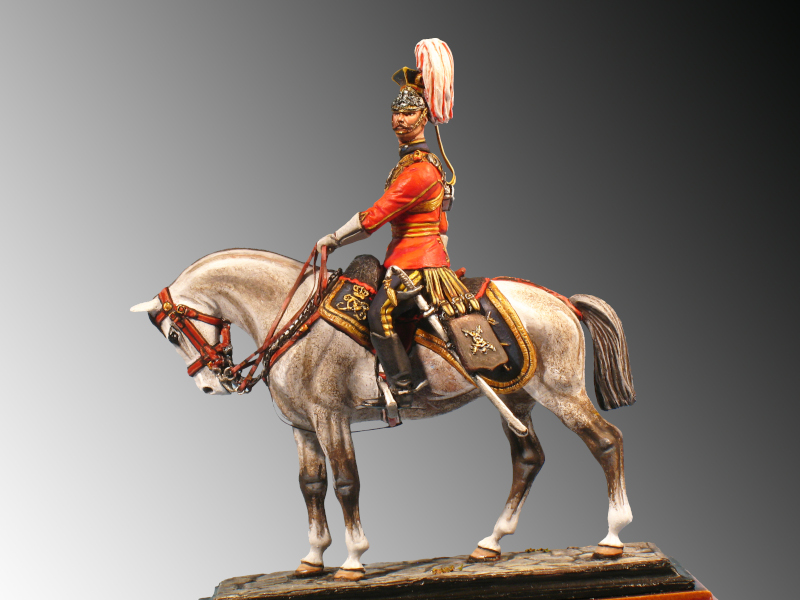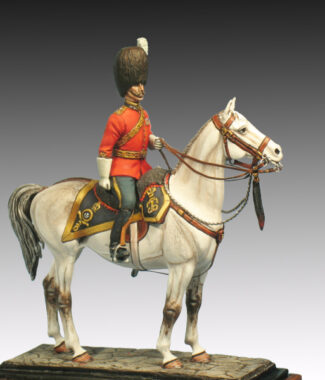You must be logged in to post a review.
16TH (THE QUEEN’S) LANCERS – 1878. OFFICIER.
€65.00
Figure to assemble and paint
Ref.: 5 – CT
Weight: 250 grs.
Material: Metal blanco
Number of Pieces: 18
Historical Review:
6TH (THE QUEEN’S) LANCERS – 1878. OFFICIER.
Raised in 1759 as 16th Regiment of (Light) Dragoons.
1766 – 2nd (or The Queen’s) Regiment of (Light) Dragoons.
1769 – 16th (or The Queen’s) Regiment of (Light) Dragoons.
1816 – 16th (The Queen’s) Regiment of (Light) Dragoons (Lancers).
1861 – 16th (The Queen’s) Lancers.
1921 – 16th The Queen’s Lancers.
1922 – Amalgamated with the 5th Royal Irish Lancers to form the 16th/5th Lancers.
1954 – 16º/5º The Queen’s Royal Lancers
1993 – Amalgamated with the 17º/21º Lancers to form the The Queen’s Royal Lancers
Battle Honours: Early Wars: Beaumont, Willems, Talavera, Fuentes d’Onor, Salamanca, Vittoria, Nive, Peninsula, Waterloo, Bhurtpore, Ghuznee 1839, Afghanistan 1839, Maharajpore, Aliwal, Sobraon, Relief of Kimberley, Paardeberg, South Africa 1900-02.
The Great War: Mons, Le Cateau, Retreat from Mons, Marne 1914, Aisne 1914, Messines 1914, Armentières 1914, Ypres 1914 ’15, Gheluvelt, St. Julien, Bellewaarde, Arras 1917, Scarpe 1917, Cambrai 1917, Somme 1918, Amiens, Hindenburg Line, Canal du Nord, Pursuit to Mons, France and Flanders 1914-18.
In 1837, the Regiment had returned to Meerut after its presence in Cawnpore. Extraordinary events in Afghanistan in 1838, and a perceived (but unfounded) threat from Russia, led to the First Afghan War (1839-41), an appalling venture conceived by the Governor General of India, George Eden, Earl of Auckland. The 16th Lancers joined what was termed the British ‘Army of the Indus’ commanded by Lt. Gen. Sir Willoughby Cotton. The Regiment marched to Delhi and then on through the inhospitable regions of the North West frontier. In February 1839, the army crossed the broad River Indus on a pontoon bridge, thereafter (marching at night and resting by day) crossing the hot desert towards the Bolan Pass. The 16th Lancers formed the vanguard of the army through the Pass, which stretches sixty-three miles through mountainous country infested with hostile tribesmen.
In April 1839, the British army reached the lush environment Kandahar, where they rested amongst “waving crops of wheat, barley and lucerne” for three months, procuring remounts for the 147 horses that had died in the Bolan Pass. As the British moved east in June, the first of what was to become continuous skirmishing occurred with local tribesmen. In August, the British entered Kabul and the Regiment camped in lush fields outside the city. Peace (apparently) restored, the Regiment left Kabul and returned to India in October. 1 officer, 10 men and 13 horses drowned during a river crossing, making a total of 3 officers, 83 men and 231 horses killed during the campaign. (The disastrous ‘Retreat from Kabul’ and the loss of Elphingstone’s army was to occur two years later, in 1842). By 1840, the Regiment had regained the safety of Meerut. During twenty-four years’ service in India, from 1822 to 1846, the regiment fought in the First Afghan War (1839-1841), the Maharatta War (1843) and the First Sikh War (1845-46), where their charge at Aliwal is especially remembered.
Returning home to England in 1846, the Regiment enjoyed some twenty years of comparative peace. They successfully petitioned to retain their scarlet jackets when a Royal Warrant required other light cavalry regiments to return to the blue jacket in 1846. The 16th Lancers returned to India, and the North-West Frontier, for eleven years from 1865 to 1876. They served in South Africa from 1878-80, fighting the Zulu War, and then from 1890 to 1899 they returned to India. When war was declared in South Africa, the Regiment embarked from Bombay and arrived in South Africa in January, 1900. During the Second Boer War (1899-1902), the 16th Lancers formed the 3rd Cavalry Brigade with the 9th Lancers and 17th Lancers under Brigadier Gordon. They were immediately involved in the relief of Kimberley (February) and the occupation of Bloemfontein (March). Thereafter, the Regiment faced constant guerrilla warfare from the Boers until peace was declared in 1902.
In its early years as the 16th Light Dragoons, the regiment wore the standard red uniform of this branch of cavalry with black and then royal blue facings. In 1784 the red coat was replaced by a dark blue jacket. From 1816 to 1832 a dark blue lancer uniform was worn, until in December 1832 a scarlet coatee and undress jacket was authorized for all lancer regiments as part of a general policy to make red the national military colour. In 1840 it was ordered that Light Cavalry should revert to the blue uniforms formerly worn. Sir John Vandeleur petitioned that the regiment might be permitted to retain their scarlet coatee and on 2 March 1841, his request was granted. The scarlet uniform was worn by the regiment during the First Sikh War and on their return to England in 1846, they remained the only Lancer regiment not to resume the blue jacket of the light cavalry. The unique distinction of scarlet lancer tunic and dark blue plastron was retained in full dress until 1914.
White plumes on red plumes were standard for officers’ chapska from 1874 to 1883.








Reviews
There are no reviews yet.